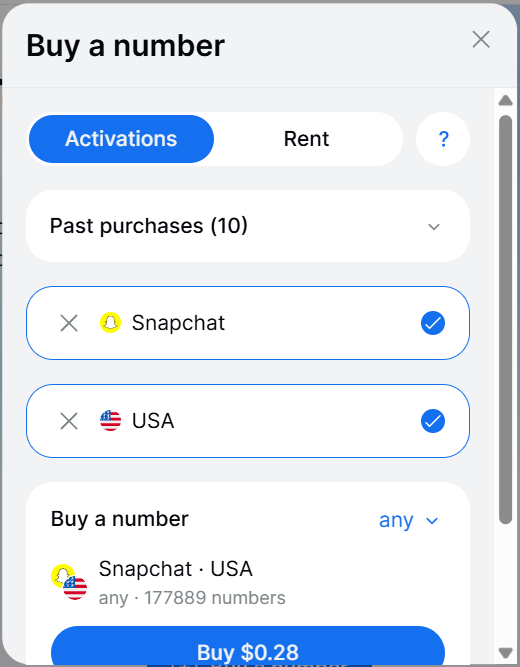Snapchat Without Phone Number: 3 Easy Ways to Sign Up Safely
Snapchat, like most modern platforms, asks for a phone number to confirm each account belongs to a real person and to reduce spam or bot activity. While this adds a layer of security, many users hesitate to share their personal number for valid reasons — from protecting privacy to maintaining separate identities or avoiding unwanted contact syncing.
In some regions, Snapchat’s verification process can even block sign-ups if local carriers aren’t supported, making it difficult to create an account at all. Fortunately, there are safe, legitimate, and privacy-friendly ways to register without exposing your personal number.
In this guide, you’ll learn three practical methods to sign up for Snapchat securely — whether through a virtual number, an email-only setup, or a secondary SIM/eSIM for privacy. Each approach offers its own balance of anonymity, reliability, and account protection, helping you enjoy Snapchat freely without compromising your personal data.
Why Snapchat Requires a Phone Number
Snapchat asks for a phone number mainly to verify that each account belongs to a real person and to prevent mass-created spam or bot profiles. This step also helps the platform protect the community from scams and automated content. When you sign up, Snapchat uses your number to send a short SMS code that confirms you’re a legitimate user.
Another reason for requesting your number is contact syncing and account recovery. By linking a number, Snapchat can automatically suggest friends from your phone’s contact list and make it easier to recover access if you forget your password or lose your device. It’s a convenience feature — but it also means your number is stored in Snapchat’s system.
Still, many users prefer not to link their personal number for privacy reasons. Some want to keep social and personal identities separate, while others manage multiple accounts or don’t want their contacts automatically discovered. For these situations, using a virtual number is a practical and safe alternative that keeps personal data off the platform.
Method 1: Use a Virtual Number to Receive SMS Verification
A virtual or temporary phone number is an online line that works through the Internet rather than a physical SIM card. It allows you to receive SMS messages remotely — perfect for signing up on Snapchat without exposing your personal number.
Here’s how it works, step by step:
- Choose a trusted temporary number service. Try SMSFAST, which supports Snapchat verifications and has country options like the U.S., Canada, or the U.K.

- Copy the provided number. Go to Snapchat’s sign-up screen and paste this number in the phone field.
- Wait for the SMS verification code. Refresh the service’s inbox until you see the message from Snapchat.
- Enter the code on Snapchat. Once confirmed, your account is verified and ready to use.
Pros and Cons of Using Virtual Numbers
| Pros | Cons |
| Keeps your personal number private | Public numbers may be reused by others |
| Simple browser-based setup | Messages may fail if the number is overused |
| Available in many countries | Some services have limited free availability |
| Helps bypass regional restrictions | Paid plans might be needed for stability |
Several reliable platforms provide this feature. SMSFAST, for instance, is made only for receiving SMS messages and verification codes — it doesn’t support making or receiving calls. It’s known for quick delivery and global coverage. Other solid options include:
- net – offers numbers from over 150 countries and real-time code updates.
- OnlineSim – combines public and private number options with more than 190 supported regions.
- SMS-Activate – great for automation or multiple-account testing, with API access.
- GetSMSCode – provides private and semi-private numbers for higher verification success.
Each of these works well for Snapchat verification, though success rates vary by region and number type (public vs. private). Paid or semi-private numbers usually give more reliable results for long-term use.
Free vs. Paid Virtual Numbers
| Category | Free Numbers | Paid / Private Numbers |
| Key Benefits | No cost, quick access for temporary verifications | Exclusive use, higher delivery rate, better privacy |
| Limitations | Publicly visible messages, higher failure rates | Requires a small fee |
| Best For | Testing or one-time sign-ups | Long-term Snapchat accounts or reliable verification |
Method 2: Sign Up Using an Email Only
If you prefer a completely phone-free Snapchat setup, you can create your account using only an email address. Snapchat’s registration page or app allows you to skip the phone field entirely — just tap “Sign Up with Email” when prompted. You’ll still be able to verify your identity through a link sent to your inbox.

This method works best for users who value anonymity or personal-data minimalism. Once the account is created, you can reinforce its protection by activating two-factor authentication (2FA) through an authenticator app like Google Authenticator or Authy. This approach avoids phone numbers altogether while keeping the account safe from unauthorized logins.
Pros and Cons of Using Email
| Pros | Cons |
| No need to share a personal number | Harder account recovery if the email is lost |
| Quick and simple registration | No automatic contact syncing |
| Works perfectly with authenticator apps for 2FA | Limited verification options for future changes |
Method 3: Use a Secondary SIM or eSIM for Privacy
For those managing multiple identities — such as content creators, business owners, or app testers — a secondary SIM card or eSIM offers an excellent balance between security and convenience. It provides a real, dedicated number that can receive verification codes without exposing your personal line.
Using a separate number also improves account recovery and stability, since Snapchat recognizes it as a valid, persistent phone link. Many modern smartphones support dual SIM or eSIM, allowing you to keep both your main and Snapchat-specific lines active simultaneously.
Pros and Cons of Using a Secondary SIM or eSIM
| Pros | Cons |
| Keeps your personal number completely private | Requires an extra SIM card or eSIM plan (may cost more) |
| Reliable delivery of verification codes | Some regions or devices may have limited eSIM support |
| Provides full access to recovery and password reset tools | Setup can be slightly technical for first-time users |
| Works seamlessly for managing multiple Snapchat or brand accounts | Switching between SIMs may cause minor app logouts or re-verification |
| Offers long-term stability and legitimacy compared to temporary numbers | May still link your secondary number to your identity if registered under your name |
When to choose this method
- You run social media projects or brand accounts
- You test apps or manage multiple digital identities
- You want long-term reliability over temporary access
How Snapchat Detects Fake or Spam Numbers
Snapchat’s verification system automatically checks the reputation of every number submitted during sign-up. It uses several filters:
- Carrier and region validation: ensures the number belongs to an active, legitimate mobile provider.
- Blacklist and reputation databases: numbers reported for spam, mass registrations, or automated activity are flagged and blocked.
- Rate-limiting algorithms: if the same number (or a group from the same range) is used to create multiple accounts within a short period, Snapchat’s system marks them as high risk.
- Behavioral monitoring: newly created accounts that instantly send friend requests, links, or messages trigger additional verification challenges.
That’s why trusted SMS-receiving platforms matter — reputable providers refresh and rotate their numbers regularly, keeping them off spam lists and ensuring they pass Snapchat’s automated screening.
Safety Tips for Signing Up Without a Phone Number
- Use only trusted SMS services. Reputable platforms protect user data and provide active, clean numbers.
- Don’t reuse public numbers. Once a number appears on multiple websites, it’s likely flagged or recycled, increasing the risk of verification failure.
- Never share received verification codes. Codes are single-use and should remain private — sharing them can compromise your account.
- Stay compliant with Snapchat’s Terms of Service. Avoid automation or fake identity use; it can lead to instant suspension.
- Choose private or paid numbers for long-term access. Paid or semi-private lines are safer, more stable, and less likely to be blocked by Snapchat’s filters.
Conclusion
Signing up for Snapchat without a personal phone number is not only possible — it’s a smart move for anyone who values privacy and control over their data. Whether you use a virtual number, rely on email verification, or set up a secondary SIM, the key is choosing trusted, legitimate tools and following safe verification practices.
By staying compliant with Snapchat’s Terms of Service, keeping verification codes private, and using reputable providers, you can enjoy all the platform’s features without linking your real number.
In short, Snapchat privacy starts with how you verify — and with the right method, you can protect your identity while still staying connected, creative, and secure online.







